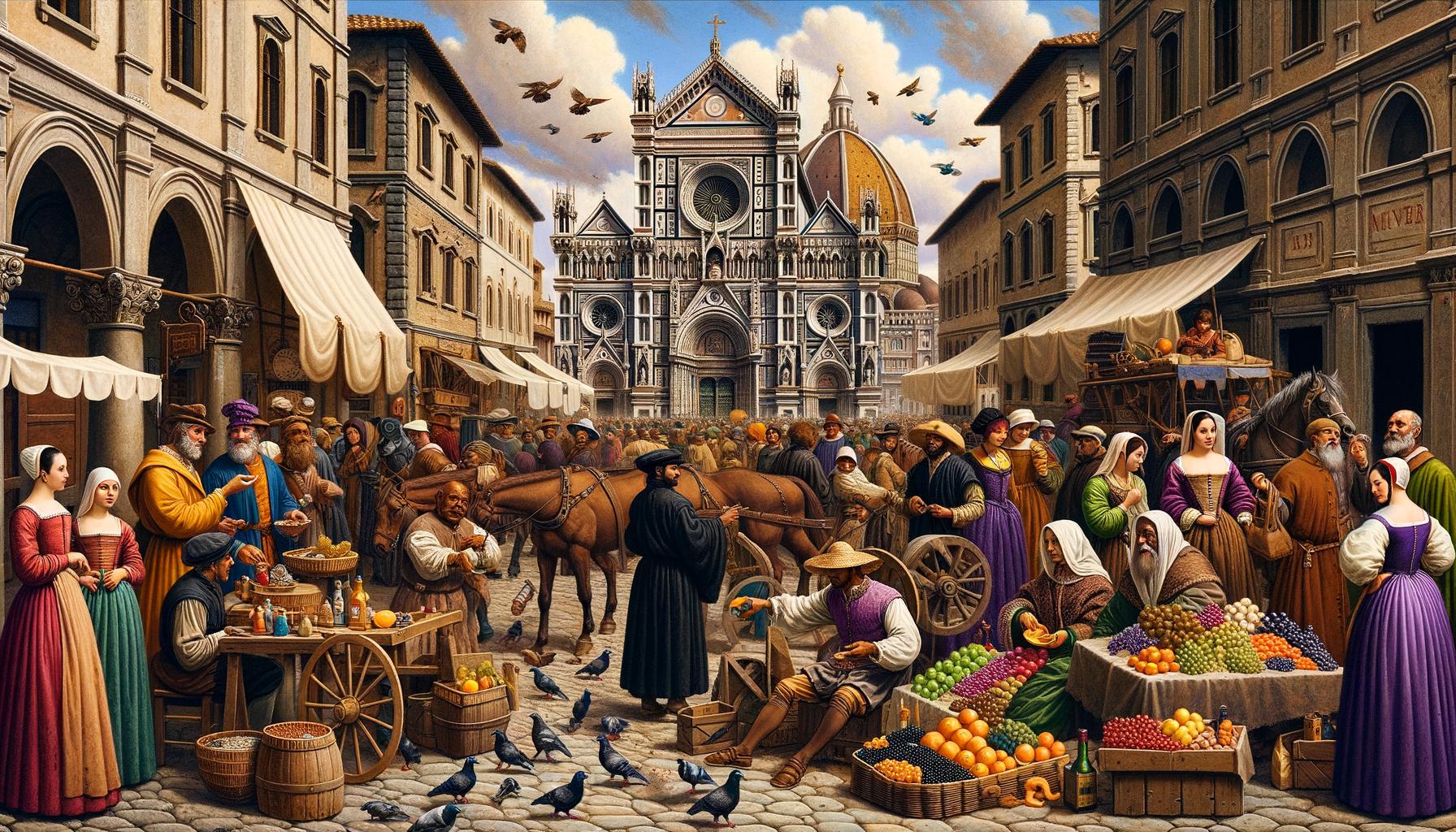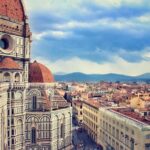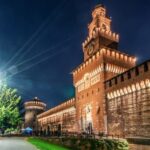Traveling times in Renaissance Italy were shaped by a variety of factors including the available roads, modes of transportation, and the purpose of the journey. In this article, we will delve into the intricacies of traveling during the Renaissance period, exploring everything from the routes and roads used to the time it took to travel across Italy.
During the Renaissance, Italy was an intricate web of city-states, each with its own unique culture and identity. This diversity made traveling within Italy an adventure in itself as merchants, artists, and intellectuals navigated through different territories and landscapes. The various modes of transportation available also played a crucial role in determining the length of travel times as well as how accessible certain locations were.
In this exploration of traveling in Renaissance Italy, we will examine not only how people moved from one place to another but also why they undertook these journeys. Whether it was for trade or cultural exploration, traveling during the Renaissance was an essential part of everyday life and contributed significantly to the interconnectedness of Italian society. Join us as we embark on a journey through time to uncover the fascinating world of travel in Renaissance Italy.
Roads and Routes
Traveling in Renaissance Italy was a remarkable experience, and navigating the Italian Peninsula presented both challenges and opportunities for travelers. The roadways of Renaissance Italy were crucial for connecting various regions and cities, facilitating trade, cultural exchange, and the movement of people. Here are some key points about roads and routes in the Italian Peninsula:
- Major Trade Routes: The Italian Peninsula had an extensive network of trade routes that connected major cities such as Florence, Venice, Milan, Rome, and Naples. These routes were vital for economic growth and the exchange of goods, ideas, and culture during the Renaissance period.
- Condition of Roads: While major cities were well connected by trade routes, traveling between smaller towns and rural areas often meant encountering unpaved or poorly maintained roads. Travelers relied on their own means of transportation or hired guides to navigate these challenging terrains.
- Significance of Roads: The development of road networks allowed for easier travel within Italy’s diverse landscapes, from the Apennine Mountains to the fertile plains of Tuscany. Additionally, these roads played a crucial role in promoting tourism and pilgrimage to religious sites such as Rome, Florence, and Venice.
Understanding the intricacies of roads and routes in Renaissance Italy provides valuable insight into how people moved across the peninsula during this significant period in history. Whether it was for trade, cultural exploration, or simply reaching a destination, the roadways laid the foundation for travel experiences during this era. Today’s travelers can appreciate how these historical pathways have contributed to shaping modern transportation systems.
Transportation
In Renaissance Italy, the means of transportation evolved significantly, from the reliance on horseback to the use of carriages. This shift not only improved the efficiency of travel but also contributed to the overall development and progress of Italian society during this period.
Horseback Travel
During the early years of the Renaissance, traveling by horse was the most common and practical mode of transportation across Italy. Many roads were unpaved, making it necessary for travelers to ride on horseback. While this form of travel was effective in navigating through rough terrain and reaching remote areas, it was often uncomfortable and time-consuming.
The Emergence of Carriages
As Renaissance Italy saw advancements in engineering and design, carriages began to emerge as an alternative mode of transportation. These carriages offered a more comfortable and convenient way to travel for those who could afford them. However, they were initially limited to the wealthy due to their high cost. Over time, technological improvements in road infrastructure made it possible for carriages to become a more accessible option for a broader range of travelers.
Impact on Society
The transition from horseback travel to carriage travel marked a significant shift in Italian society during the Renaissance. The ability to cover longer distances in shorter amounts of time allowed for increased trade, communication, and cultural exchange between cities and regions. This improvement in transportation not only facilitated economic growth but also played a crucial role in cultivating a sense of unity and interconnectedness among the diverse communities within Renaissance Italy.
Traveling by Sea
Italy’s extensive coastline and numerous port cities made traveling by sea a common and efficient mode of transportation during the Renaissance. The country’s geographical location allowed for easy access to the Mediterranean, and as a result, maritime travel played a significant role in both trade and exploration.
One of the most important aspects of traveling by sea in Renaissance Italy was the development of advanced sailing techniques, which allowed sailors and merchants to navigate more effectively. Ships were equipped with improved rigging systems, making them better able to withstand the strong currents and unpredictable weather conditions of the Mediterranean Sea. The use of compasses and navigational maps also contributed to safer and more accurate sea travel.
The coastal cities of Italy, such as Venice, Genoa, and Naples, became bustling hubs for maritime activity. These cities served as important ports for trading goods such as silk, spices, and precious metals with other regions in Europe and beyond. Additionally, they attracted travelers seeking new experiences and cultural exchange. With well-established ports and thriving economies, these cities provided ideal starting points for journeys across the Mediterranean.
| Aspect of Travel | Impact on Travel |
|---|---|
| Development of sailing techniques | Enabled safer navigation at sea |
| Coastal cities as trading hubs | Facilitated economic growth through maritime commerce |
| Cultural exchange | Attracted travelers looking for new experiences |
Inns and Accommodations
Traveling in Renaissance Italy often meant long and arduous journeys, making inns and accommodations a crucial part of the experience. During this time, there were a variety of options available for travelers to rest during their journey, ranging from simple lodgings to more upscale accommodations. Inns were scattered along the major roads and routes across the Italian Peninsula, providing a place for weary travelers to eat, sleep, and tend to their horses.
In addition to inns, travelers could also find lodging at monasteries and convents throughout Italy. These religious institutions often offered hospitality to pilgrims and other travelers as part of their charitable activities. The accommodations provided by these religious establishments varied widely in terms of comfort and amenities, but they served as an important resource for those on the move.
For those with more means, hiring a private residence or villa was also an option during the Renaissance. Wealthy travelers could arrange for lodging in the homes of local nobility or wealthy landowners, offering a more luxurious experience compared to staying at public inns or religious establishments.
Based on historical accounts and travel diaries from the Renaissance period, it is clear that finding suitable accommodations was an essential consideration for anyone traveling across Italy during this time. From humble inns along the roads to opulent residences in major cities, where one rested during the journey played a significant role in shaping the overall travel experience.
| Types of Accommodations | Description |
|---|---|
| Inns | Scattered along major roads; provided basic lodging and meals |
| Monasteries/Convents | Offered hospitality to travelers; varied in comfort and amenities |
| Private Residences/Villas | Luxurious option for wealthy travelers; arranged through local nobility or landowners |
Traveling for Trade
During the Renaissance, Italy was a bustling hub of commerce and trade, attracting merchants from all across Europe and beyond. The Italian Peninsula’s strategic location at the crossroads of East and West made it an ideal destination for those seeking to engage in business and commerce. This section will explore the significance of trade in Renaissance Italy, including the types of goods that were traded and the impact of commerce on the overall economy.
Types of Goods Traded
During the Renaissance, Italy became known for its diverse range of products that were traded both domestically and internationally. Some of the most sought-after goods included textiles such as silk, wool, and cotton, as well as precious metals, spices, and luxury items like fine art and jewelry. The city-states of Florence, Venice, Genoa, and Milan were particularly renowned for their skilled artisans and craftsmen who produced high-quality goods that were in demand throughout Europe.
Impact on the Economy
The thriving trade industry had a profound impact on the economy of Renaissance Italy. The influx of wealth from trade allowed for significant investment in art, architecture, education, and technology. Additionally, it fostered a culture of innovation and creativity as merchants sought new markets and products to trade. The economic prosperity brought about by trade also led to increased patronage for artists and scholars, ultimately contributing to the flourishing cultural environment that characterized the Renaissance.
Trade Routes
Italy’s extensive network of trade routes connected it with major European cities such as Constantinople (Istanbul), Alexandria, Paris, London, and Amsterdam. The transportation infrastructure developed during this time facilitated the movement of goods by land and sea across great distances.
Merchants traveled along these well-established routes to conduct business transactions while also fostering cultural exchange between different regions. Whether by caravan through mountain passes or by ship along coastal waters, these routes played a vital role in shaping commercial activity during the Renaissance.
As can be seen through an analysis of traveling times in Renaissance Italy within this context we are able to understand how important commerce was during this time period in shaping not only economics but also every day life across Europe.
Traveling for Art and Culture
During the Renaissance period, Italy was home to some of the most magnificent cities in the world. Cities like Florence, Venice, Rome, and Milan were hubs of art and culture, drawing travelers from all over Europe to witness the beauty and creativity that thrived within their walls. These cities were not only important centers of commerce and trade but also a pilgrimage for artists, writers, and intellectuals who sought inspiration from the rich cultural tapestry of Renaissance Italy.
Artistic Meccas: Florence and Venice
Florence, often considered the birthplace of the Renaissance, was a focal point for artists such as Leonardo da Vinci, Michelangelo, and Botticelli. The city’s rich artistic heritage can still be seen today in its impressive galleries, churches, and palaces. Similarly, Venice’s opulent architecture and vibrant art scene made it a must-visit destination for travelers during the Renaissance. The city’s unique blend of Eastern and Western influences created an aesthetic unlike any other in Italy.
The Seat of Power: Rome and Milan
Rome, with its ancient ruins and grand Vatican City, was a pilgrimage site for those seeking to witness the glory of classical antiquity alongside the height of Christian artistry. Milan, on the other hand, was a thriving center for fashion, design, and innovation during the Renaissance. Visitors were drawn to its grand cathedrals and palazzos that displayed the wealth and power of its ruling families.
Cultural Immersion
Traveling through these magnificent cities allowed visitors to immerse themselves in the artistic achievements of the era. The bustling streets were alive with artisans creating masterpieces in painting, sculpture, literature, music, and architecture. Travelers could attend performances at lavish theaters or partake in intellectual conversations at salons hosted by prominent thinkers. All these experiences made traveling through Renaissance Italy an unforgettable journey filled with artistic wonderment.
As travelers journeyed from one captivating city to another during this golden age in Italian history, they took with them not only memories but also influences that would shape their own creative endeavors across Europe.
Traveling Times
Traveling in Renaissance Italy was an adventure that required careful planning and patience, especially when considering the amount of time it took to travel across the Italian Peninsula. The distances between cities, the condition of the roads, and the modes of transportation available all played a significant role in determining traveling times in this era.
In Renaissance Italy, the average traveling speed for a horse-drawn carriage was around 4-5 miles per hour on well-maintained roads. However, many roads were not well-paved, making travel slower and more challenging. As a result, a journey from Florence to Rome, for example, which is approximately 170 miles (275 kilometers) apart, could take anywhere from 7 to 12 days by carriage.
For those who preferred traveling by sea, the time it took to navigate coastal cities also varied. While shorter distances could be covered relatively quickly using sailing vessels or galleys, longer journeys across the Mediterranean Sea could take several weeks depending on weather conditions and trade winds.
With such considerations in mind, it becomes clear that traveling times in Renaissance Italy were considerably longer than what we are accustomed to today. However, these lengthy journeys offered travelers an opportunity to appreciate the beauty of the Italian landscape and immerse themselves in the rich culture and history of each region they passed through.
Conclusion
As we conclude our exploration of traveling times in Renaissance Italy, it becomes evident that the experience of traveling during this historical period was both fascinating and challenging. The Italian Peninsula offered a diverse landscape for travelers, from the coastal cities to the magnificent inland destinations. Navigating this terrain required an understanding of the roads and routes available, as well as the modes of transportation, whether by sea or land.
The length of time it took to travel across Renaissance Italy varied depending on the mode of transportation and the distance to be covered. Whether traveling for trade, art, culture, or simply for leisure, individuals had to consider the factors affecting their journey, including rest stops at inns and accommodations along the way.
Despite these challenges, traveling in Renaissance Italy allowed for the exploration of new ideas and cultures, contributing to the interchange of knowledge and commerce across the Italian Peninsula.
In conclusion, reflecting on the experience of traveling in Renaissance Italy allows us to appreciate the significance of this period in history. The development of trade networks, cultural exchange, and artistic innovation were all influenced by the movement of people throughout Italy. As we look back on this era, we gain a deeper understanding of how travel shaped the Renaissance period and left a lasting impact on Italian society and beyond.
Frequently Asked Questions
How Did People Travel During the Renaissance?
People traveled during the Renaissance primarily by foot, horseback, or by sea. Walking was the most common form of travel for short distances, while horses were used for longer journeys. Sea travel was also important due to the era’s global exploration.
What Was the Mode of Transportation in the Renaissance Period?
The mode of transportation in the Renaissance period consisted of various means such as carriages, wagons, and boats. Carriages and wagons were used on land for transporting goods and people, while boats and ships were essential for overseas exploration and trade.
What Was the Time Range of the Renaissance?
The Renaissance time range is generally considered to have occurred from the 14th century to the 17th century. However, this varies depending on regional differences and developments in art, culture, and science. In Italy, for instance, it started earlier than in other parts of Europe.

I’m a passionate traveler, writer, and Italophile. My fascination with Italy’s history, art, and culture has led me on countless adventures across the Italian landscape. Through “I Live Italy,” I share my love for this extraordinary country and aims to inspire others to explore its boundless beauty.





